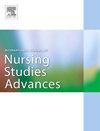Development of a behaviour change intervention to increase care home staff influenza vaccination uptake
IF 3.1
Q1 NURSING
International Journal of Nursing Studies Advances
Pub Date : 2025-07-24
DOI:10.1016/j.ijnsa.2025.100387
引用次数: 0
Abstract
Background
To protect care home residents the World Health Organisation recommends that 75 % of care home staff are vaccinated for influenza. In the UK this value is less than 30 %. Previously reported interventions have not been informed by theory and usually only addressed one or two known barriers to uptake. Using behavioural science, we worked with care home staff to develop an intervention which addressed all barriers at both individual and care home level.
Methods
We developed an online questionnaire, derived from the literature, asking staff about barriers and facilitators of flu vaccination. These were prioritised (based on frequency and distinctiveness), then mapped to the Theoretical Domains Framework. Relevant behaviour change techniques were identified. Care home staff selected and designed behaviour change techniques according to affordability, practicability, effectiveness, acceptability, safety and equity (APEASE) via an online questionnaire and workshop.
Results
The prioritised barriers were: lack of time to get vaccinated; insufficient vaccine supplies; vaccination costs; a lack of peers getting vaccinated and beliefs that staff do not need vaccination and that it is ineffective. Six behaviour change techniques were selected and developed into a multi-component intervention: (behaviour change technique 1, Restructure of the physical environment) Free, in care home vaccination clinics for staff; (behaviour change techniques 2–4, Information about health consequences, Salience of consequences and information about others’ approval) information campaign featuring care home staff highlighting non-vaccination risks, (behaviour change techniques 5–6, Information about health consequences and Credible source) information campaign featuring primary care doctor challenging misconceptions.
Conclusions
We developed the first theory and evidence-based intervention specifically to facilitate care home staff flu vaccination uptake. Feasibility and acceptability testing of the intervention followed by definitive trial to assess efficacy in care homes is necessary to inform policy decision-making.
制定行为改变干预措施,以增加护理院工作人员接种流感疫苗
背景为了保护安老院的住客,世界卫生组织建议75%的安老院员工接种流感疫苗。在英国,这一比例不到30%。以前报道的干预措施没有理论依据,通常只解决一两个已知的障碍。利用行为科学,我们与护理院的工作人员一起开发了一种干预措施,解决了个人和护理院层面的所有障碍。方法我们根据文献编制了一份在线问卷,询问工作人员流感疫苗接种的障碍和促进因素。这些被优先排序(基于频率和独特性),然后映射到理论领域框架。确定了相关的行为改变技术。护理院工作人员通过在线问卷调查和研讨会,根据可负担性、实用性、有效性、可接受性、安全性和公平性(APEASE)来选择和设计行为改变技术。结果优先考虑的障碍是:缺乏接种时间;疫苗供应不足;疫苗接种成本;缺乏接种疫苗的同伴,认为员工不需要接种疫苗,接种疫苗无效。选择了六种行为改变技术,并将其发展成一种多成分干预措施:(行为改变技术1,重建物理环境)在护理之家诊所免费为工作人员接种疫苗;(行为改变技术2-4,关于健康后果的信息,后果的突出性和关于他人批准的信息)以养老院工作人员强调非疫苗接种风险为特点的信息运动(行为改变技术5-6,关于健康后果的信息和可靠来源)以初级保健医生挑战误解为特点的信息运动。我们开发了第一个理论和基于证据的干预措施,专门促进养老院工作人员接种流感疫苗。对干预措施进行可行性和可接受性测试,然后进行明确的试验,以评估护理院的疗效,这对政策决策是必要的。
本文章由计算机程序翻译,如有差异,请以英文原文为准。
求助全文
约1分钟内获得全文
求助全文
来源期刊

International Journal of Nursing Studies Advances
Nursing-General Nursing
CiteScore
5.80
自引率
0.00%
发文量
45
审稿时长
81 days
 求助内容:
求助内容: 应助结果提醒方式:
应助结果提醒方式:


